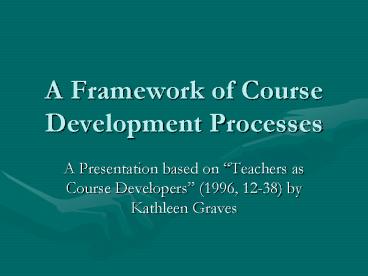A Framework of Course Development Processes - PowerPoint PPT Presentation
1 / 21
Title:
A Framework of Course Development Processes
Description:
Conceptualizing content: What will be the backbone of what I teach? ... How Goals and Objectives Provide a Framework ... Work with a set of possible activities ... – PowerPoint PPT presentation
Number of Views:1253
Avg rating:3.0/5.0
Title: A Framework of Course Development Processes
1
A Framework of Course Development Processes
- A Presentation based on Teachers as Course
Developers (1996, 12-38) by Kathleen Graves
2
Framework Components
- Needs assessment What are my students needs? How
can I assess them so that I can address them? - Determining goals and objectives What are the
purposes and intended outcomes of the course?
What will my students need to do or learn to
achieve these goals? - Conceptualizing content What will be the
backbone of what I teach? What will I include in
my syllabus? - Selecting and Developing Materials and
activities How and with what will I teach the
course? What is my role? What are my students
roles? - Organizing of content and activities How will I
organize the content and activities? What systems
will I develop? - Evaluation How will I assess what students have
learned? How will I assess the effectiveness of
the course? - Consideration of resources and constraints What
are the givens of my situation?
3
Needs Assessment
- Objective Needs
- - these are related to students backgrounds,
language abilities and intended use of the TL
beyond the classroom. - Subjective Needs
- - these relate to students attitudes toward
the target language and target culture, toward
learning in general, and toward themselves as
learners.
Subjective needs are often as important as
objective needs
4
Who Provides Info About Needs?
- Students
- Teachers
- Funders
- Parents
- Administration
- Employers
- Future Professors
It depends on the situation, right?
5
How to Conduct a Needs Assessment
- Questionnaires
- Interviews
- Observations
- Samples of Written Materials
- Proficiency Test Scores
Needs assessment should be an ongoing process
6
Needs Assessment as an Ongoing Process
- Mindmapping
- Student Generated Questionnaires
- Dialogue Journals
- Discussion with Students
7
Determining Goals and Objectives
- Goals general statements of the overall,
long-term purposes of the course - Objectives express the specific ways in which
the goals will be achieved
8
How Goals and Objectives Provide a Framework
- They are a basis for determining which content
and activities are appropriate for the given
situation. - They help enable us to form a framework for
evaluating the effectiveness and worth of an
activity.
9
Four Kinds of Goals
- Proficiency goals general competency in the
enabling skills (i.e., reading, writing, etc.) - Cognitive goals include mastery of formal
linguistic knowledge and cultural knowledge. - Affective goals promote positive attitudes
toward learning, the TL, the classroom
environment, the teacher, peers, and so on - Transfer goals the ability to call on skills
learned in one situation in order to meet future
challenges
10
Five Kinds of Objectives
- Coverage objectives e.g., We will cover the
first five units of - Activity objectives e.g., Students will write
four different types of sentences which - Involvement objectives e.g., Students will
engage in discussions about - Mastery objectives e.g., Students will be able
to write about - Critical thinking objectives e.g., Students will
be able to determine characteristics of a good
paragraph such as
11
Conceptualizing Content
- What will be the backbone of
- what we teach?
12
The Completed Syllabus Grid
13
Selecting and Developing Materials and Activities
- How and with what will we teach the course?
14
Two Important Factors in Developing, Choosing, or
Adapting Materials
- The effectiveness in achieving the purpose of the
course - The appropriateness for the students and the
teacher
15
The text is not the course!!
16
Organization of Content and Activities
- Course Development
- What is important?
- -----Figuring out systems for organizing the
course - The lesson level
- The course level
17
Two General Principles of Sequencing
- Recycling
- Revisiting previous material in new ways
- Building
- Simple to complex
- More concrete to more open-ended
18
Two Ways to Approach the Overall Organization
- A Cycle
- Follows a consistent sequence
- A Matrix
- Work with a set of possible activities
- As the course progresses, decide which activities
to work with
19
EVALUATION
- Why does one evaluate?
- What can be evaluated?
- When does one evaluate?
- Who evaluates?
- How does one evaluate?
20
Considerations of Resources and Constraints
- What is viewed as resources and what is viewed as
constraints depends on teachers perspective - Teachers selection of materials and activities
influences the class
21
Summing Things up How this applies to the real
world.
- Resources do not matter as much as what you are
able to do with them. A good teacher can turn a
few given resources into a well designed,
effective language teaching curriculum (including
CALL applications) - Being flexible and creative with what you have is
ultimately the most important resource that a
teacher can have to overcome the constraints of a
given situation.































